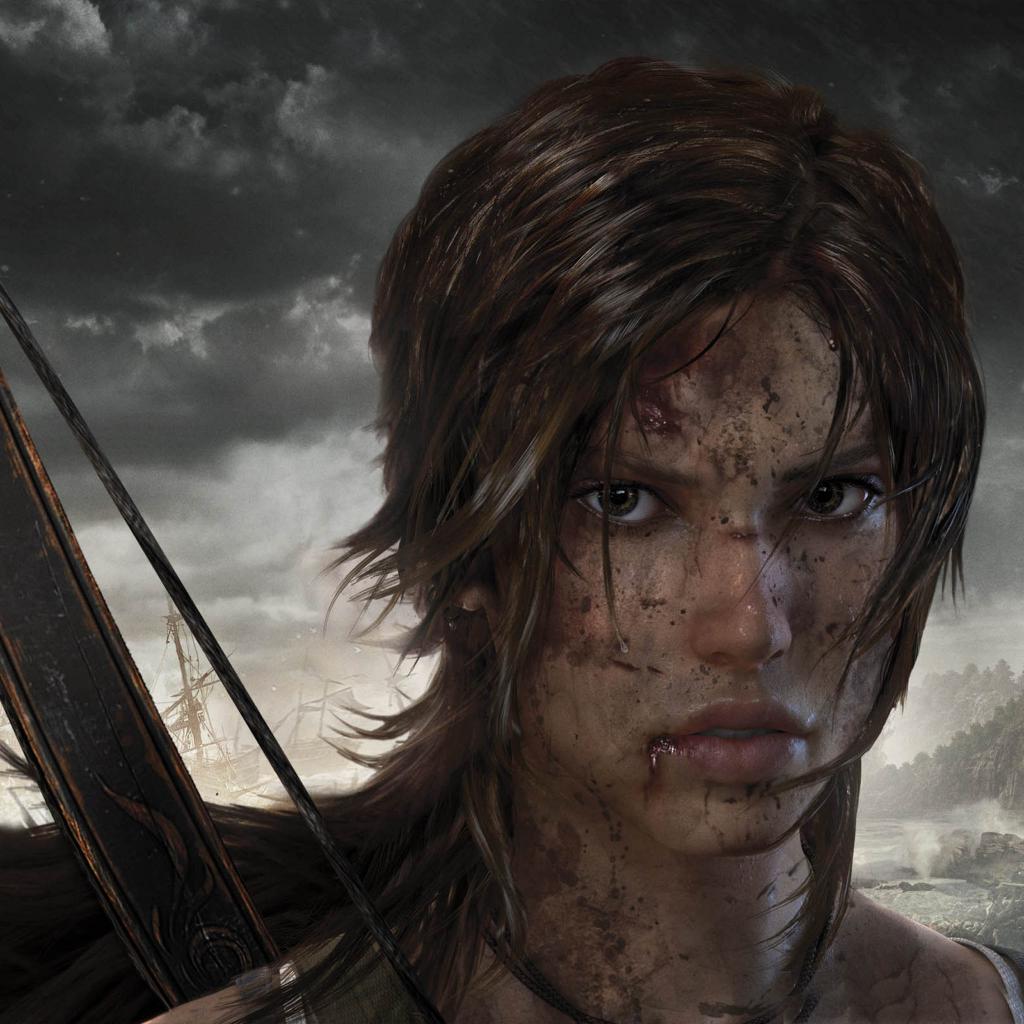Look around you at the room you’re in. Look at the furniture. Are there solid wood tables? Chairs? Doors? Does the ground underfoot seem secure? Are you on the verge of falling through the ground and smashing through a splintered wooden frame, before crashing through a plate glass window and landing painfully on some jagged rocks, then sliding down those rocks before falling off a cliff and hitting every branch of a huge tree on the way down?
No, none of that is going to happen. In the perpetually hazardous world of Tomb Raider though, you are always just seconds away from such a disaster. Tomb Raiders world is a fragile one, and in this newest game in the series, Lara is always at risk, as a floor, a roof or even a whole building collapses in a pile of rotting, splintered wood. She will always get up again though, bleeding and bruised and breathless, but even more determined than before. This is the story of how Lara’s iron-will is forged in the fires of adversity and pain. And every moment of it is glorious.
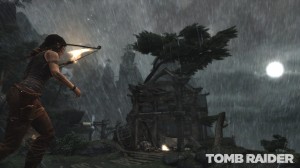 Lara’s adventures in Tomb Raider take place in one very definite location, and there’s a sense of “place” throughout. Often, the most immersive games are those that choose to focus on one location and render it in glorious detail, and like “That Island” in Far Cry 3, Tomb Raider makes its one main environment a brilliant place to explore and stunning place to look at. That’s not to say there’s no visual variety though. From underground tombs to snowy mountain peeks, Lara’s journey will take her (and you) to many different places.
Lara’s adventures in Tomb Raider take place in one very definite location, and there’s a sense of “place” throughout. Often, the most immersive games are those that choose to focus on one location and render it in glorious detail, and like “That Island” in Far Cry 3, Tomb Raider makes its one main environment a brilliant place to explore and stunning place to look at. That’s not to say there’s no visual variety though. From underground tombs to snowy mountain peeks, Lara’s journey will take her (and you) to many different places.
It’s not a huge game world though, nor is it an open one. Rather, each area is riddled with nooks and crannies to explore, but exists as a kind of hub area. It’s certainly not an open world environment; the design and structure of the world is more analogous to an Arkham game, or even something like Zelda. While the environments aren’t huge, they are absolutely littered with little secret areas in which you can find all manner of collectibles. The strength of this approach is that it allows designers to very carefully lay out interesting environments to explore, and the twisty-turny multi-layered levels of Tomb Raider are clever and complex. The design matches the high watermark of games like Ico, with the levels twisting round themselves, so that as you progress you see earlier areas from a new perspective. Often, you will change the structure of the levels as you go, creating shortcuts and paths that make it easier to make a treacherous journey the next time you take the same path.
 The game opens with a ship wreck, and you spend much of the early parts of the game doing little tasks to survive. The games focus is on survival at this point, and this part has been highlighted at length in promotional material and the playable sections we had already seen. Lara is a convincing and believable character, and when she shakes and shivers in the cold jungle rain, you worry about her. Her world seems real, or at least the threats of hypothermia, starvation and wolf attacks feel real. She is no super-woman at this point, and the things that will kill her in this hostile environment are the same things that would kill you or me if we were in the same situation.
The game opens with a ship wreck, and you spend much of the early parts of the game doing little tasks to survive. The games focus is on survival at this point, and this part has been highlighted at length in promotional material and the playable sections we had already seen. Lara is a convincing and believable character, and when she shakes and shivers in the cold jungle rain, you worry about her. Her world seems real, or at least the threats of hypothermia, starvation and wolf attacks feel real. She is no super-woman at this point, and the things that will kill her in this hostile environment are the same things that would kill you or me if we were in the same situation.
While these early sections are brilliantly presented with great sound effects, an appropriate soundtrack and some best-in-class voice acting, the survival tasks don’t make it into Tomb Raiders gameplay. It’s important to stress here that anyone who thought Tomb Raider would have systems in play relating to starvation or thirst or finding food and shelter for Lara will be disappointed. You do need to kill animals early on as part of the story for Lara to take in food, but there’s no hunger meter or anything similar. All dangers she faces are story related, and after the opening moments of the game, hunting merely amounts to popping animals like they are little pinatas of experience points.
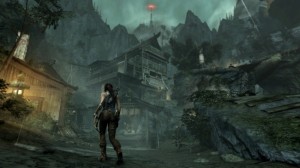 There are few big budget games that open poorly these days at devs spend lots of time hooking a player with an exciting set up, but Tomb Raider retains its momentum, and if anything you’ll be even more engrossed in the action after the two hour mark rather than before it. While the opening moments take you through the aftermath of the storm, the story is drip fed throughout the gameplay, and unlike some games where the fancy cut scenes and big set pieces disappear after the opening sections, Tomb Raiders are spread throughout the game. The pacing is near-perfect, and whether its combat, story or big action scene, you always have a bite sized piece that makes you hungry for more.
There are few big budget games that open poorly these days at devs spend lots of time hooking a player with an exciting set up, but Tomb Raider retains its momentum, and if anything you’ll be even more engrossed in the action after the two hour mark rather than before it. While the opening moments take you through the aftermath of the storm, the story is drip fed throughout the gameplay, and unlike some games where the fancy cut scenes and big set pieces disappear after the opening sections, Tomb Raiders are spread throughout the game. The pacing is near-perfect, and whether its combat, story or big action scene, you always have a bite sized piece that makes you hungry for more.
Lara moves through the game world fluidly and convincingly, and while the games visuals in general are jaw-dropping, it’s her animations that stand out. Tomb Raider feels like a game that has been playtested to death, and everything about her movement and animation feels perfect. The way that she puts her hand out as she moves close to a wall, or the way she looks at important parts of the environment are human-like and convincing in a way that few games manage. The fact that Crystal Dynamics have managed to implement all this detailed animation while making Lara feel completely responsive and easily-controllable is the real success story though. Sometimes a developer gets the essential “feel” of controls, animation and movement right, and they have really nailed it here. Whether it’s the subtle way Lara can be guided in mid air, the way she climbs, the way she takes bigger steps before a long jump or the way she grabs onto ledges, everything just feels…. right. None of the special animations for jumping or running require complex controller inputs, but Lara grabs platform edges or extends her arms as she flies through the air automatically, with clever, natural animations that just happen. It’s hard to convey in words, but in Tomb Raider you always know what jumps Lara can make which areas she can climb and where you can go. She might be the most enjoyable character to control in a third person action game, surpassing even Batman or Ezio. Guiding her through the game really is a joy.
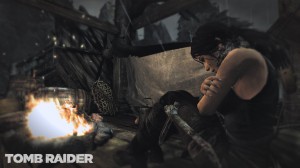 And this responsive and rewarding control extends to the combat. You will fight a lot of enemies in Tomb Raider, and the third person combat focuses on quickly eliminating enemies with your bow and axe before they realise you are even there. Once you’re spotted, waves of enemies will come at you, but Lara is a competent combatant. As you fight Lara will use cover automatically, and lean around it dynamically in a visually impressive way, but without requiring you to press a button or toggle some artificial cover mode. When leaning out to the left hand side of cover, I particularly like the way she arches her back when firing a bow and arrow. It’s the kind of lean-and-shoot that you see in movie scenes, but if present in games it usually feels overly mechanical. In Tomb Raider, you can take part in the most cinematic battles with your enemies without using anything but basic moves.
And this responsive and rewarding control extends to the combat. You will fight a lot of enemies in Tomb Raider, and the third person combat focuses on quickly eliminating enemies with your bow and axe before they realise you are even there. Once you’re spotted, waves of enemies will come at you, but Lara is a competent combatant. As you fight Lara will use cover automatically, and lean around it dynamically in a visually impressive way, but without requiring you to press a button or toggle some artificial cover mode. When leaning out to the left hand side of cover, I particularly like the way she arches her back when firing a bow and arrow. It’s the kind of lean-and-shoot that you see in movie scenes, but if present in games it usually feels overly mechanical. In Tomb Raider, you can take part in the most cinematic battles with your enemies without using anything but basic moves.
In much the same way as the jumping and combat doesn’t require complex controls despite having lots of custom animations, stealth is the same. Like in the Uncharted series, you will generally be spotted by enemies eventually, but you can normally eliminate quite a few before you are. There are stealth kills, but the really impressive part is how Lara goes into a stealthy crouch on her own. This doesn’t really slow you down, but makes you harder to spot, and it makes you conscious of the fact that you can be stealthy. Almost every encounter with enemies will start with you moving in on them silently, but you are entirely free to go in all guns blazing. Using the bow and axe is so satisfying though that I can’t imagine anyone will avoid taking out the first few enemies with stealthy arrow head-shots or brutal stealth take downs. At its best moments, you feel like a stealthy hunter stalking unwary prey, and striking from the shadows and terrorizing your screaming enemies is great fun.
 Tomb Raider will certainly draw comparisons with Uncharted, and those are fair. It’s a game that similarly alternates between combat with pirates and exploring and climbing through visual stunning environments. Whereas Uncharted wore me out with waves and waves of enemies combined with loose and unsatisfying combat mechanics though, Tomb Raider is pulse-poundingly brilliant when you’re fighting. The bow and arrow is an effective weapon from start to finish, and even when seven or eight enemies are all coming at you, you never feel like you can’t take them all on.
Tomb Raider will certainly draw comparisons with Uncharted, and those are fair. It’s a game that similarly alternates between combat with pirates and exploring and climbing through visual stunning environments. Whereas Uncharted wore me out with waves and waves of enemies combined with loose and unsatisfying combat mechanics though, Tomb Raider is pulse-poundingly brilliant when you’re fighting. The bow and arrow is an effective weapon from start to finish, and even when seven or eight enemies are all coming at you, you never feel like you can’t take them all on.
Enemies either shoot guns, throw firebombs or run at you with knives. The fire bombs stop you from staying in cover in one place for long, so you have to keep moving, while being aware of any incoming knife wielders who can kill you quickly is also essential. A dedicated dodge button helps you scramble to cover when being shot at as well as letting you avoid melee attacks, and as you unlock skills through accrued XP, you learn counter maneuvers to take enemies out quickly if your timing is good.
 There are still a lot of enemies, and in truth there are probably just a little too many. Lara says at one point after murdering the first wave of enemies: “Its scary how easy it was”. And it is. Lara is a machine of death – an avenging Goddess of war and slaughter. That’s fun, but its occasionally at odds with the tone of the game. When cut scenes show her hiding from an individual enemy, you wonder why she is so scared when she just killed twenty five of them on her own.
There are still a lot of enemies, and in truth there are probably just a little too many. Lara says at one point after murdering the first wave of enemies: “Its scary how easy it was”. And it is. Lara is a machine of death – an avenging Goddess of war and slaughter. That’s fun, but its occasionally at odds with the tone of the game. When cut scenes show her hiding from an individual enemy, you wonder why she is so scared when she just killed twenty five of them on her own.
While the combat is enjoyable, the real thrill of the game comes in exploring the environments. Tomb Raider is nothing short of stunning. On PC it may be one of the best looking games I have played. Certainly it’s one of the best this year. While many have wasted time discussing Lara’s hair, this is a little like looking at the finger pointing at the sky. The real highlight here is the environments, which are realistic and fantastically detailed while being full of clever visual flourishes. When you’re in the rainy jungle, you really do feel damp and wet and cold, and when you’re going through a crumbling mountain temple, the gaping chasms inspire genuine vertigo.
 With such a visually spectacular world to explore, rooting out all the collectibles is great fun. These add “salvage” which lets you upgrade your weapons and XP which unlocks new skills. Instead of having one specific thing to collect (like 1000 orbs), you are tasked with finding small numbers of specific items in each area. For example, in the cliffs section, you need to find 5 golden eggs. This is great, as when you collect the second or third you are incentivized to keep searching. If you were told you have found “3 of 400 doodahs” you wouldn’t be bothered about finding the rest as the task would be too daunting, but when there is only a few of an item in the area, you will feel encouraged to keep searching as you are always close to completing a set of something.
With such a visually spectacular world to explore, rooting out all the collectibles is great fun. These add “salvage” which lets you upgrade your weapons and XP which unlocks new skills. Instead of having one specific thing to collect (like 1000 orbs), you are tasked with finding small numbers of specific items in each area. For example, in the cliffs section, you need to find 5 golden eggs. This is great, as when you collect the second or third you are incentivized to keep searching. If you were told you have found “3 of 400 doodahs” you wouldn’t be bothered about finding the rest as the task would be too daunting, but when there is only a few of an item in the area, you will feel encouraged to keep searching as you are always close to completing a set of something.
Each area has a camp fire where you can upgrade items, unlock skills and warp to any other region. As your weapons are upgraded, you earn new tools to go back and open up blocked paths in previous sections of the game. This is where Tomb Raider earns its comparisons to a Metroid-Vania game, and those comparisons are valid. For example, a rope upgrade for your arrows allows you to fire them across a chasm and make a rope bridge at specific points. By going back to earlier levels, you can use this to get to areas you couldn’t reach before and find all sorts of goodies.
The game does a good job of conveying information about what collectible are available in each area and how many you have collected. As you complete the optional Temple missions (self-contained puzzle sections) you unlock maps that show the locations of everything in an area. Going back through places you’ve been to collect everything is compulsive, even for those without OCD.
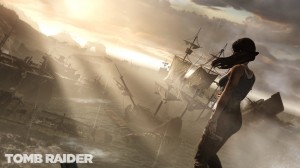 When faced with puzzle sections, they often involve fire, and are generally very clever. Some will be very obvious, and Lara’s “detective vision” mode – which highlights important objects in the game world – can make them a little too easy. Still, there’s some clever physics puzzles going on, and those who love pit traps and rumbling stone walls that shift and produce showers of dust in ancient tombs won’t be disappointed.
When faced with puzzle sections, they often involve fire, and are generally very clever. Some will be very obvious, and Lara’s “detective vision” mode – which highlights important objects in the game world – can make them a little too easy. Still, there’s some clever physics puzzles going on, and those who love pit traps and rumbling stone walls that shift and produce showers of dust in ancient tombs won’t be disappointed.
Between the combat and exploration there are some action set pieces that can contain quick time events. There are both good and bad aspects to these sections. During these, Sometimes you are just pushing a direction on the pad to progress, and you can only go one way. At one point, while squeezing into a narrow gap I realised I had missed a collectible. I couldn’t go back though, pressing in any direction made Lara go forward. Always forward.
Failing these quick time events often results in some brutally shocking deaths for Lara. I’ve seen her get a spike under her chin that came through the top of her head, perforated by arrows through the knee and neck and impaled by a pick in the chest. I’m not sure I wanted to see any of those deaths, and the cries and moans of pain are a little too much for me.
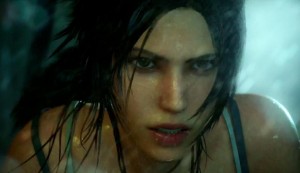 Still, some of these set pieces blow away even the best parts of the Uncharted games. At times the game switches brilliantly to fixed camera angles for effect. And an early set piece with a plane sliding down a hill will leave you breathless and exhilarated. Later, an even better scene arises where you are swept away by a fast running river and have to dodge rocks before smashing though the wreck of an airplane. As you fall out the plane over a waterfall, you grab a parachute and and end up guiding Lara through a spiky tree canopy. These moments are exciting not because you are a super-action hero who will definitely survive, but because you are perilously close to the perpetual threat of a horrifying death.
Still, some of these set pieces blow away even the best parts of the Uncharted games. At times the game switches brilliantly to fixed camera angles for effect. And an early set piece with a plane sliding down a hill will leave you breathless and exhilarated. Later, an even better scene arises where you are swept away by a fast running river and have to dodge rocks before smashing though the wreck of an airplane. As you fall out the plane over a waterfall, you grab a parachute and and end up guiding Lara through a spiky tree canopy. These moments are exciting not because you are a super-action hero who will definitely survive, but because you are perilously close to the perpetual threat of a horrifying death.
All of this is accompanied by some of the best characters and voice acting I’ve seen in a big budget game in a long time. The Scottish sea captain from Glasgow is an obvious favourite of mine, but everyone has their moments, and you really believe this cast of characters are real and have histories together as well as complex motivations for what they do.
But even all of this great design doesn’t explain why I love Tomb Raider so much. Thinking about it for a long time, I finally came to an answer. Tomb Raider is the Die Hard of games. Lara is John McClane. Ok, she’s a different gender, but she encapsulates everything that’s right about that character in the first Die Hard movie. She’s not a modern action star, she’s a classic one. She is human. She is in a terrible situation. She is vulnerable. When she falls, it hurts. She has to rely on her wits and ingenuity to survive. She’s not a Master Chief or an Ezio. Instead, she’s that friend of yours whose a little tougher than you are, and a little more resilient. The one who would try to save us if we were in trouble, even if they probably had no chance of success.
When Lara falls, she gets back up. Dirt and blood and broken bones; she feels all of it, but she keeps going anyway. Because she’s a real character. Because she’s a hero.
9 bruised, bleeding, brilliant Lara’s out of 10
